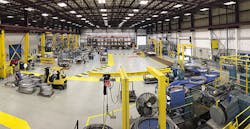A skilled welder isn’t born fully fledged. Neither is a superior athlete or an excellent attorney. They train. Mastering a language takes instruction and then practice, practice and more practice. So does playing the piano with any skill. Why should mastering lean be any different?
Few would argue that it should be. Indeed, Eric Lussier, vice president, Steel Business System, for Steel Partners, is adamant that training is key to developing a sustainable lean culture. “Culture is the only thing that is sustainable,” he says. “That is why we have such a heavy emphasis on training, to build the culture.”
But how much training, who needs it, for how long, and what kinds of training are just a few of the questions that begin to bubble up once a manufacturing organization decides to take the lean leap. They are important questions. As Jim Rowland, vice president of St. Louis-based Watlow notes: “I believe an organization is an organism. If you’re not continually feeding it, if you’re not continually trying to grow it, it’s going to die. And that’s what happens with most lean organizations.”
Watlow, on the other hand, has embraced lean for more than a decade, and at Steel Partners’ Handy & Harman, the lean implementation spans some eight years. These organizations share training lessons learned along the way.
Blocking and Tackling
Lussier is a big believer in lean and continuous improvement as drivers of business success. The vice president speaks thoughtfully but enthusiastically about building communities of problem-solvers, rooting out waste, total associate involvement and, of course, the tools of lean: 5S, strategy deployment, value stream mapping, and many more.
“If I have 100 people on the floor, I want 100 people working on making improvements and problem-solving,” Lussier says.
|
Launching a Lean Transformation Jon Armstrong, executive vice president at Simpler Consulting, offers these bits of wisdom to manufacturers embarking on a lean transformation: 1. “We believe companies and individuals first need to know why before they know how. It’s important to start with the principles.” 2. “It’s very tempting to go too fast, too soon.” Resist the temptation. “It takes a degree of discipline and patience to build the acquired capabilities.” 3. You need a coach. The temptation by companies is to say, “This looks easy from where I’m sitting. We don’t need a coach.” 4. You can’t delegate improvement. “You have to roll up your sleeves and participate.” 5. Don’t stint on dedicated resources. |
Building a culture of lean is his aim at Handy & Harman, a business of Steel Partners and a diversified industrial organization comprised of nearly 10 businesses and more than 30 manufacturing sites. In general, the companies that comprise Handy & Harman don’t have common customers, common suppliers or common processes. Where they unite is under the common umbrella of the Steel Business System, with its foundation of lean as a management philosophy.
“[Lean] is how we become competitive as a company. To me there is nothing more important,” Lussier says.
Lean training at Handy & Harman is robust. It includes formal lean 101 training for all employees, which is part of new employees’ onboarding; weeklong lean leadership training and lean learning kaizens. “Our approach focuses a lot on blocking and tackling basics, but it’s the best way we have found to deploy the continuous improvement framework of lean across our diverse companies,” Lussier states.
The lean 101 training is just as its name implies – basic. In four to six hours of primarily classroom training, employees are introduced to the Steel Business System, as well as 5S, visual management, basic problem solving and kaizen as a concept. The goal is to show new employees, early on, “that we’re focused on lean and here’s the way we look at it. It’s part of our culture, part of our DNA,” Lussier says.
Be Prepared to Roll Up Your Shirt Sleeves
The weeklong lean leadership training is typically for salaried personnel. Lussier describes it as a survey course that provides broad exposure to many classical lean tools, including kanban, cell design, standard work and strategy deployment. “I don’t expect people to become an expert in set-up-time reduction or kanban from the class,” the vice president explains. Instead, he says, the goal is to make students more aware of tools that exist to help them solve problems in their area of influence.
“Ultimately,” he says, “it’s not really about the tools; it’s about the problems you are solving.”
The Value of 'Shiny Eyes'
Beyond simply a classroom experience, this training includes lean exercises and simulations, as well as actual work on the manufacturing floor. For example, after training in the 5S module, participants are given a 5S audit sheet and an area to audit. The benefit is twofold, Lussier says. “One, they are exercising the tool...and two, the value stream leaders in those areas get feedback from someone who’s never been in the plant before. We call it ‘shiny eyes’ or a fresh set of eyes.”
Two keys points to this training are that it must occur at a manufacturing site so participants can both see and do what they are learning; and it involves cross-company participation from multiple Handy & Harman companies. “I’m driving a little bit of unity between people to know that they are part of something much bigger under the Handy & Harman umbrella,” he says.
Similarly, lean learning kaizens are cross-company training efforts, with participants studying a tool or tools and participating in kaizen events at manufacturing sites. The hosting company benefits as the recipient of the kaizen event and participants from other Handy & Harman companies benefit by gaining an employee trained in the tool who can take it home and perhaps lead a kaizen event there.
Leadership Engagement is a Must
Where does executive leadership fit during a lean transformation? “Your entire executive team has to agree that lean is the way that you are going to relentlessly improve your business. That has to be a fundamental core,” says Watlow’s Rowland. Watlow manufactures thermal systems for a broad range of industries, from 10 manufacturing sites.
Moreover, at Watlow, executive lean involvement extends beyond mere agreement. “I can tell you that 90% of our executive team has been through our lean training, either lean product development or lean Six Sigma training, and it could be 100%,” says Rowland. Not only has the executive leadership taken part in classroom training, but they also have participated in kaizen events, either leading the effort or taking part as a team member.
Similarly, Steel Partner’s Lussier recently held a kaizen event in Warwick, R.I., with the Handy & Harman company presidents. Three kaizen teams addressed challenges of variation reduction, Total Productive Maintenance and set-up time reduction.
Why the presidents? The point, says Lussier, is leadership: “What are the two most famous words in leadership? Follow me. Set the example, and walk the talk.”
It’s All About Application
Watlow’s Rowland can’t emphasize enough the importance of developing leaders who truly understand how to apply lean every day in their jobs. “This is the piece of training I think most people miss,” he says, and one that even Watlow can struggle with—and continually works to improve. It’s the difference between “having the knowledge and being able to apply the right tools in the right situation.”
“We know all the tools. We have people who could literally walk you through all the tools, and know every sentence and every word about them,” he says. Even so, an individual can get so caught up in a tool that he or she tries to force it into a process it’s not right for. Or pursue a kaizen event because one is required without thinking through whether it is an appropriate event.
More than a decade ago, Simpler Consulting worked with Watlow to implement the Watlow Business System. Rowland has brought the consulting firm back on board to help improve the manufacturer’s lean application capability to deliver the right results.
“I call it the minute by minute, hour by hour, day by day application of the lean tools,” Rowland says.
Continuous improvement efforts even apply to Handy & Harman’s lean training. “We actually work on the training so that every time it is delivered, we’ve tweaked and adjusted and tried a new exercise,” Lussier says. “I’m not talking about wholesale changes, but we take feedback and say, ‘How do I make this better?’”






